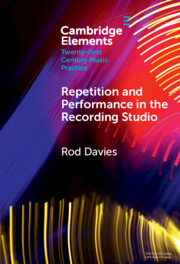781 results
Two - Craftiness and Productivity in Bodily Things
-
- Book:
- Minoan Zoomorphic Culture
- Published online:
- 17 May 2024
- Print publication:
- 06 June 2024, pp 38-101
-
- Chapter
- Export citation
45 - The Pleasures of Reading Camp
- from How to Recognize the Queer Past before (and during) the Advent of Medicalization
-
-
- Book:
- The Cambridge History of Queer American Literature
- Published online:
- 17 May 2024
- Print publication:
- 06 June 2024, pp 801-817
-
- Chapter
- Export citation

Democracy, Theatre and Performance
- From the Greeks to Gandhi
-
- Published online:
- 17 May 2024
- Print publication:
- 27 June 2024
9 - Celebrity Bodies
- from Part II - Black Optics
-
-
- Book:
- The Cambridge Companion to the Black Body in American Literature
- Published online:
- 09 May 2024
- Print publication:
- 16 May 2024, pp 128-144
-
- Chapter
- Export citation
Chapter 33 - Griselda Gambaro and Beyond: A “Dermography” of Contemporary Women’s Theater and Performance
- from Part III - Literary Names
-
-
- Book:
- A History of Argentine Literature
- Published online:
- 09 May 2024
- Print publication:
- 16 May 2024, pp 520-535
-
- Chapter
- Export citation
Performing Nigerianness: Equivocal Identities and Digital Legibility of White Women Comedians
-
- Journal:
- African Studies Review , First View
- Published online by Cambridge University Press:
- 13 May 2024, pp. 1-21
-
- Article
- Export citation
“The human face of the UN plastics treaty”? The role of waste pickers in intergovernmental negotiations to end plastic pollution and ensure a just transition
-
- Journal:
- Cambridge Prisms: Plastics / Volume 2 / 2024
- Published online by Cambridge University Press:
- 30 April 2024, e12
-
- Article
-
- You have access
- Open access
- HTML
- Export citation

Performing Grief in Pandemic Theatres
-
- Published online:
- 19 April 2024
- Print publication:
- 23 May 2024
-
- Element
- Export citation
Relationship among thermal environment, stage of lactation, body characteristics, yield and milk constituents of dairy Gyr cows managed on pasture
-
- Journal:
- Journal of Dairy Research , First View
- Published online by Cambridge University Press:
- 08 April 2024, pp. 1-6
-
- Article
- Export citation
2 - Facial Recognition Technologies 101
- from Part I - Facial Recognition Technology in Context
-
-
- Book:
- The Cambridge Handbook of Facial Recognition in the Modern State
- Published online:
- 28 March 2024
- Print publication:
- 04 April 2024, pp 29-43
-
- Chapter
-
- You have access
- Open access
- HTML
- Export citation
Chapter 7 - Audiences
- from Part III - Theatre Communities
-
-
- Book:
- The Cambridge Companion to British Theatre since 1945
- Published online:
- 14 March 2024
- Print publication:
- 21 March 2024, pp 147-165
-
- Chapter
- Export citation
Public Piety in Nigeria's Recent History - Performing Power in Nigeria: Identity, Politics, and Pentecostalism Abimbola A. Adelakun. Cambridge: Cambridge University Press, 2021. Pp. 290. $99.99, hardcover (ISBN: 9781108831079); ebook (ISBN: 9781108923194).
-
- Journal:
- The Journal of African History , First View
- Published online by Cambridge University Press:
- 04 March 2024, pp. 1-3
-
- Article
- Export citation
Three - Painting with Music
-
- Book:
- Divine Music in Archaic and Classical Greek Art
- Published online:
- 01 February 2024
- Print publication:
- 29 February 2024, pp 115-157
-
- Chapter
- Export citation

A Performance History of The Fair Penitent
-
- Published online:
- 26 February 2024
- Print publication:
- 21 March 2024
-
- Element
- Export citation
3 - Fragmenting Frauenliebe und -leben
-
-
- Book:
- The Lied at the Crossroads of Performance and Musicology
- Published online:
- 09 February 2024
- Print publication:
- 15 February 2024, pp 55-77
-
- Chapter
- Export citation
Introduction
-
-
- Book:
- The Lied at the Crossroads of Performance and Musicology
- Published online:
- 09 February 2024
- Print publication:
- 15 February 2024, pp 1-9
-
- Chapter
- Export citation
9 - Singers Speak about Musicology and Performance
-
-
- Book:
- The Lied at the Crossroads of Performance and Musicology
- Published online:
- 09 February 2024
- Print publication:
- 15 February 2024, pp 188-199
-
- Chapter
- Export citation
1 - In Search of Song
-
-
- Book:
- The Lied at the Crossroads of Performance and Musicology
- Published online:
- 09 February 2024
- Print publication:
- 15 February 2024, pp 10-33
-
- Chapter
- Export citation

Repetition and Performance in the Recording Studio
-
- Published online:
- 12 February 2024
- Print publication:
- 14 March 2024
-
- Element
- Export citation
Introduction - Experiencing Rituals
-
-
- Book:
- Senses, Cognition, and Ritual Experience in the Roman World
- Published online:
- 04 January 2024
- Print publication:
- 25 January 2024, pp 1-26
-
- Chapter
- Export citation



